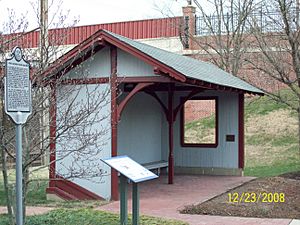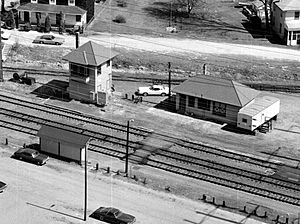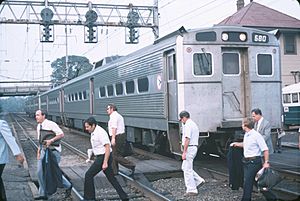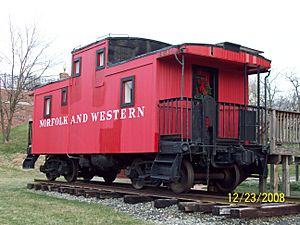Bowie Railroad Buildings facts for kids
Quick facts for kids
Bowie, MD
|
|||||||||||||||||||||||||||||||
|---|---|---|---|---|---|---|---|---|---|---|---|---|---|---|---|---|---|---|---|---|---|---|---|---|---|---|---|---|---|---|---|
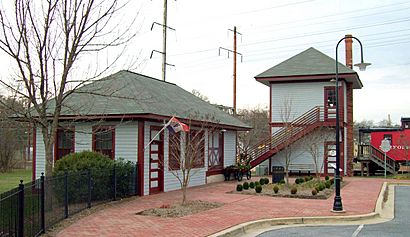
Bowie Tower and freight station in December 2008
|
|||||||||||||||||||||||||||||||
| Location | 8614 Chestnut Avenue, Bowie, Maryland | ||||||||||||||||||||||||||||||
| Operated by | Baltimore and Potomac Railroad Pennsylvania Railroad Amtrak MARC |
||||||||||||||||||||||||||||||
| History | |||||||||||||||||||||||||||||||
| Opened | 1872 | ||||||||||||||||||||||||||||||
| Closed | 1989 | ||||||||||||||||||||||||||||||
| Electrified | January 28, 1935 (ceremonial) February 10, 1935 (regular service) |
||||||||||||||||||||||||||||||
| Former services | |||||||||||||||||||||||||||||||
|
|||||||||||||||||||||||||||||||
|
Bowie Railroad Buildings
|
|||||||||||||||||||||||||||||||
| Area | less than one acre | ||||||||||||||||||||||||||||||
| Built | 1913 | ||||||||||||||||||||||||||||||
| Architectural style | Queen Anne | ||||||||||||||||||||||||||||||
| NRHP reference No. | 98001261 | ||||||||||||||||||||||||||||||
| Added to NRHP | November 4, 1998 | ||||||||||||||||||||||||||||||
The Bowie Railroad Buildings are three old train station buildings in Bowie, Maryland. They are located where the Northeast Corridor train line meets the Pope's Creek Subdivision. The group of buildings includes a one-story building for cargo, a two-story tower for controlling train tracks, and a covered area for passengers.
Trains used this station from 1872 until 1989. After that, a new station called Bowie State station opened nearby. In 1992, the old buildings were fixed up and became the Bowie Railroad Museum. They were added to the National Register of Historic Places in 1998. This means they are important historical sites.
History of Bowie Station
Before the train station even opened, people were buying land in the area. They hoped the land would become more valuable when the Baltimore and Potomac Railroad (B&P) was built. In 1870, a man named Benjamin Plumb, who planned the town, sold land to the railroad. He made a deal that the land had to be used for a station and an engine house by 1875.
The train line from Baltimore to Washington opened on July 2, 1872. The section from Washington to Bowie was first a smaller branch line. But it soon became a very important route. The Pope's Creek Branch opened in January 1873. By then, the Bowie station was open at the train junction.
The station was named after Oden Bowie, who owned the railroad. He was also the governor of Maryland from 1869 to 1872. The city itself was renamed Bowie in 1880.
In the 1880s, a new system called an "interlocking system" was invented. This system allowed one worker in a special tower to control many train switches using electric levers. The Bowie Tower, which controlled the main train junction, opened in the 1890s. It sadly burned down in 1910.
The Pennsylvania Railroad (PRR) had taken over the B&P railroad in the 1870s. They fully bought it in 1902. After the fire, the PRR quickly built a new tower to replace the old one.
In the early 1930s, the PRR started making the main train line straighter and better. A new station building was built in the same spot. A small passenger shelter was also built across the tracks. In 1934, the PRR moved an interlocking tower from Severn to Bowie Junction. This tower had been built in 1913. Passenger train service from Bowie to Pope's Creek stopped on October 29, 1949. However, the line continued to be used for moving cargo.
Train Services: Amtrak and MARC
The Pennsylvania Railroad became part of Penn Central in 1968. In May 1971, Amtrak took over long-distance passenger train service. Bowie and most other local stations only had limited commuter service. This service was still run by Penn Central.
Conrail took over the Baltimore-Washington commuter service in 1976. The Maryland Department of Transportation (MDOT) soon started paying money to help keep this service running.
In 1978, Amtrak started running a commuter train called the Chesapeake. It traveled between Washington and Philadelphia, stopping at local stations like Bowie. Amtrak then took over running the Baltimore-Washington service for MDOT on January 1, 1983. The Chesapeake train was stopped on October 30, 1983, because the other Amtrak and MDOT services made it less necessary.
The MARC brand replaced AMDOT in 1984. On February 27, 1989, MARC train service moved to Bowie State station. This new station is at Bowie State University. It had space for a large parking lot where people could park their cars and then take the train. It also had easier access to Route 197.
Bowie Tower was used until 1986. That's when the system that controlled signals and tracks on the line became computerized. After that, the three old buildings – the station, the shelter, and the tower – were closed up and not used.
Bowie Railroad Museum
In 1992, the City of Bowie bought the buildings. They moved them about 100 feet away from the main train line. The Maryland Historical Trust helped fix them up. The buildings were restored to their old Pennsylvania Railroad colors: gray with burgundy trim.
These buildings are important because they show how train transportation grew in the area. They are also good examples of the types of buildings found at small train junctions in the early 1900s. These old train station buildings in Bowie are rare. Not many early 20th-century railway stations are left in the Washington, D.C., area.
The buildings were reopened as the Huntington Railroad Museum. Later, it was renamed the Bowie Railroad Museum. It's a small railway museum run by the city. A wooden train car called a caboose from 1922 was also on the museum grounds. It was from the Norfolk and Western Railroad.
This caboose got old and worn out. So, in August 2016, it was replaced. A different caboose, which used to belong to the B&O Railroad, was brought from the B&O Railroad Museum in Baltimore.
The main station building now has exhibits and old items. The tower holds a special library for railroad research. The buildings were added to the National Register of Historic Places as the Bowie Railroad Buildings in 1998.




